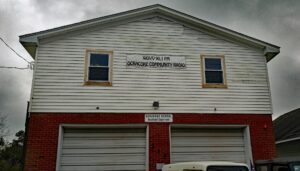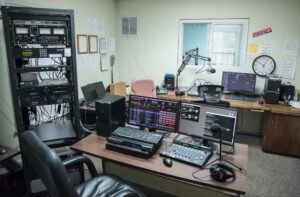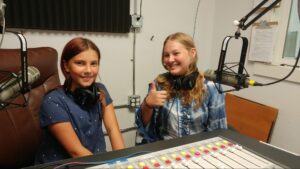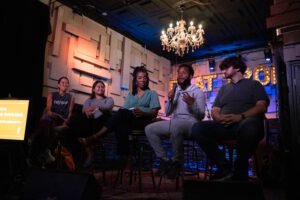By Catherine Komp
Engagement Director
In August 2011, Peter Vankevich was anxious. He has just bought a house on Ocracoke and was looking for news on Hurricane Irene’s impacts on the island.
“We were worried about it and I wasn’t getting any news,” said Vankevich.Then he remembered hearing about a new radio station. He put WOVV in an online search and found the stream. At that time, the community radio station was broadcasting out of a tiny kiosk right on the harbor. On the air, Vankevich says he heard a growly voice, who he’d learn later was Nathan Modlin, describing the scene.
“And he says, ‘the winds are picking up, the water is starting to spill over the docks now and it’s starting to go into the street.’ I’m afraid I’m not going to be able to hang on much longer here because I got to get home and now it’s really pouring into the village,’” recalled Vankevich.
But first, Modlin said, “we’ll go back to some music” and played the 1968, 17 minute-long track “In-A-Gadda-Da-Vida” by Iron Butterfly.
“And, it hit me twice,” said Vankevich. “First of all, I got the news [about Irene] and any radio station that plays In-A-Gadda-Da-Vida is on my A list. The others would lose money by putting that on.”
 Vankevich was so moved he sent the station a $100 donation and two weeks later, got a letter back. It included a thank you card and a standing invitation to do a radio show. Weeks after relocating to Ocracoke in March 2012, Vankevich launched a local public affairs program and says he’s rarely missed a show since.
Vankevich was so moved he sent the station a $100 donation and two weeks later, got a letter back. It included a thank you card and a standing invitation to do a radio show. Weeks after relocating to Ocracoke in March 2012, Vankevich launched a local public affairs program and says he’s rarely missed a show since.
Vankevich’s story is unique to him, but it’s also quintessential community radio: hyperlocal delivery of news and information that no one else is providing; locally produced music shows and curated playlists unencumbered by what’s charting; and a culture that opens its doors to community members who want to learn how to make radio.
North Carolina has dozens of community stations and LPFMs (not counting religious broadcasters). Asheville has three: WRES 100.7, Asheville FM 103.3 and WPVM 103.7. A bit further north, Marshall’s WART 95.5, licensed to the Madison County Arts Council, has operated from a little red caboose on Main Street. Raleigh has both WKRP 101.9 (yes, it’s a reference to that KRP) and Oak 93.5 serving the area with their own distinct mix of news, talk and music. And, this September, WCOM 103.5 marks 20 years on the air in Chapel Hill and Carrboro.
This is not an exhaustive list, but it gives you a snapshot of these important players in the local news and information ecosystem. (And if anyone knows of or wants to help make a comprehensive map of community radio stations in NC, please let me know.)
Today we’re going to get to know two of them: WOVV (also known as Ocracoke Community Radio) and its neighbor Radio Hatteras.
Born from necessity
With the Atlantic on the east and Pamlico Sound on the west, the 30 square mile Hatteras Island is home to about 4,000 people. After the widespread damage from Hurricane Isabel in 2003, which destroyed part of Highway 12 and left many residents stranded for weeks, the need for reliable information during times of crisis became more apparent.
 Jim Kinghorn, the former GM of Cape Hatteras Electric Cooperative, along with Richard Marlin and Lou Browning, began rallying support for a radio station to serve the local community. It took more than a decade and lots of help from local agencies and groups, but in 2014 Radio Hatteras finally got on the air. They have two stations, WHDZ 101.5 in Buxton and WHDX 99.9 in Waves, which covers the whole island.
Jim Kinghorn, the former GM of Cape Hatteras Electric Cooperative, along with Richard Marlin and Lou Browning, began rallying support for a radio station to serve the local community. It took more than a decade and lots of help from local agencies and groups, but in 2014 Radio Hatteras finally got on the air. They have two stations, WHDZ 101.5 in Buxton and WHDX 99.9 in Waves, which covers the whole island.
Mike Hennessey, a volunteer on the station’s operations committee, told NC Local that the vision and mission of the station is to be the trusted source for news and information during emergencies.
“When everything goes down, people need to know, for example, where the dune breached, where the road is flooded, if there’s some other emergency situation going on, where to go if you have a medical emergency, all that kind of information and there are times when the only way to get that information out is with radio,” said Hennessey. “That is the reason that Radio Hatteras exists.”
Located in a sturdy brick Dare County building on the sound side of the island, the station has two transmitters and two antennas in two different locations, all with backup generators. They maintain landline DSL in addition to wifi hotspots and a Starlink satellite connection.
“And then as the absolute fall back, we have amateur radio. So we have multiple ways to communicate should everything go down,” said Hennessey.
When storms are approaching, Radio Hatteras puts their emergency plan into action. Two or three people camp out at the station and gather information from emergency management and NWS officials to share on the air. Offsite volunteers are scheduled for four-hour shifts to listen to the broadcast and feed back other information they’re seeing or hearing from their part of the island.
“Fortunately, most of the time we don’t have an emergency, so we play music,” said Hennessey.
In addition to locally programmed and hosted music shows, Radio Hatteras airs events of the day, PSAs from local government agencies and the Cape Hatteras Electric Cooperative, a local stargazing segment and a local “This day in history” module. Additionally, a weekly news segment rounds up everything from the Dare County Commissioners and Buxton Civic Association, to beach clean-ups, local fundraisers and employees of the month.
Ocracoke’s “Village Voice”
Ocracoke’s WOVV 90.1 also provides a lifeline to residents during storms and other emergencies. During sunnier days, it’s a space for in-depth conversations on local news and culture.
Volunteer Peter Vankevich, who retired from the Library of Congress and is co-publisher of the Ocracoke Observer, hosts the two-long-hour “What’s happening on Ocracoke” each Friday and covers “a bit of everything.”
“For example, if you know about the Outer Banks these days, the NC Ferry Division has had just a miserable time,” explained Vankevich. “Especially last fall and winter, primarily because of the shoaling. The sand gets into the channels and it causes the boats to be damaged so they have to pull them out for repair. So I had on Jed Dixon, he’s the director of the NC Ferry Division, he came on my radio show and explained what was going on.”
Vankevich brings on the county commissioner and the Superintendent for the Cape Hatteras National Seashore. He’ll interview local musicians and artists and those, like Lister Hewan-Lowe, who fell in love with the Outer Banks and repeatedly return. Local culture is a common theme on the show; a few days ago, he interviewed one of the organizers of the Ocracoke Fig festival.
“People say to me, ‘how long is this [interview] going to run?’ And I say, ‘I’ll tell you what, this is community radio. We’ll both know when we’re finished,’” said Vankevich with a laugh, adding “I have that flexibility, which another radio station doesn’t have.”
Longtime listeners delight in the unexpected that arises from the free form of community radio. While the sound might not always be polished, there’s an authenticity in hearing friends, neighbors and colleagues on the air.
At WOVV, they also open the mic for young people. After moving into the old fire station, which was deeded to the local school, the station started an afterschool training program for students and began broadcasting baseball and basketball games.
“Two years, three years ago, the boys basketball team were going big time, going to the state tournaments,” said Vankevich. “I had the coach and his best player on during a lunch break.”

And that’s another part of the connectedness of these Outer Banks radio stations: high school sports are big local news stories that get a spotlight outside of the live broadcasts. It’s where a fourth grader can launch “Island Girl Talk,” water rescue teams are thanked on the air and listeners get updates on the progress of an accessible bathhouse. While many new hyperlocal digital sites are being launched across the country, community radio stations have been filling these local news and information gaps for decades.
Community radio is traditionally scrappy, and that is true of these Outer Banks institutions. Both stations have tiny budgets: about $60,000 for WOVV and about $26,000 for Radio Hatteras, according to recent 990 filings. Much of their equipment is donated and they rely on passionate volunteers to keep things running, raise funds and create local content.
The stations have a limited digital presence beyond simple websites, Facebook pages and live streams they promote to “off islanders” to stay connected. But radio remains a vital medium on the Outer Banks and Radio Hatteras and Ocracoke Community Radio have established themselves as trusted partners, collaborators and sources of local news and information for their communities, during emergencies, times of leisure and everyday life.
“We’re a small community, literally, I mean, we’re 1200 maybe year round,” said Vankevich. “So we know each other. We know the infrastructure, so it’s manageable. You can get your hands on it and understand it.”
Other local news resources in the Outer Banks
➡️ The Ocracoke Observer: co-published by Vankevich and Connie Leinbach, the 25-year-old publication has “nature” as a primary news beat. They print a monthly edition for most of the year, along with regular digital distribution. They’ve won about 50 awards for their coverage, including first place NCPA award for editorials the last two years, and publish articles in multiple languages.
➡️ The Island Free Press: founded by veteran journalist Irene Nolan in 2007 and owned by Publisher Donna Barnett, the digital news outlet’s mission is to provide news and information and “encourage a better conversation about the issues that face islanders and visitors every day.”
➡️ The Outer Banks Voice: launched in 2010, the digital news site covers community news, business, sports and more and is owned by Rick Loesch, owner of East Carolina Radio Inc., and Mark Jurkowitz, who previously owned the Outer Banks Sentinel.
➡️ SamWalkerOBXNews.com: longtime OB reporter Sam Walker started this Patreon site after the digital start-up WOBX ceased operations last year. He covers local government, civic and cultural issues.
➡️ Coastal Review: founded in 2012 by the NC Coastal Federation to fill the gap in coastal environmental reporting and the loss of dedicated environmental reporters across the state, Coast Review provides news briefs, features and special reports.
Are we missing any news and information sources on the Outer Banks? Send us a note and let us know at nclocal@elon.edu.
Corrections: An earlier version of this story included incorrect call letters for WHDZ 101.5 in Buxton and an incorrect spelling of Mike Hennessey’s last name. Both have been corrected.




